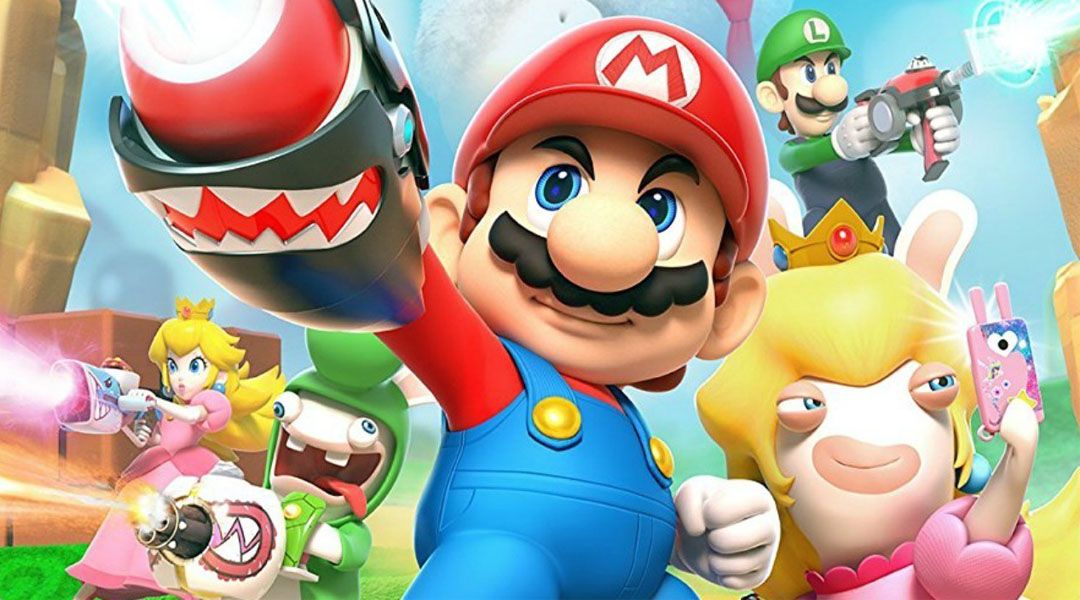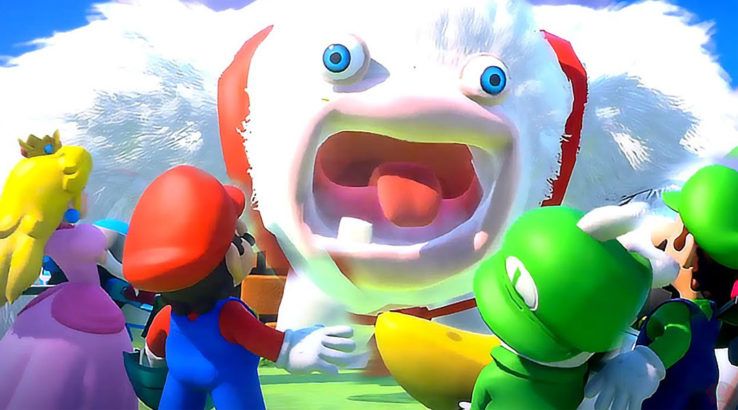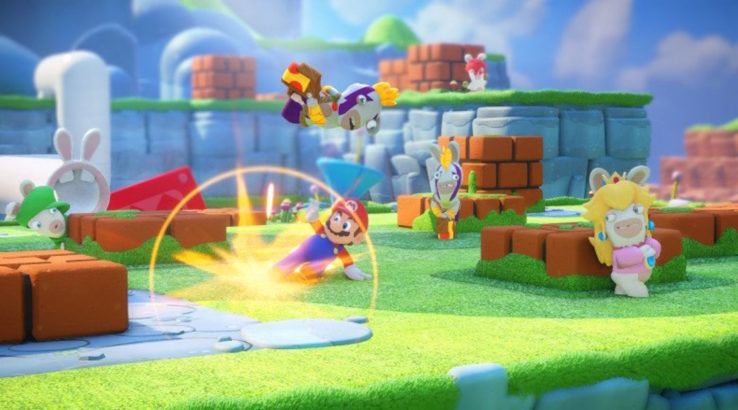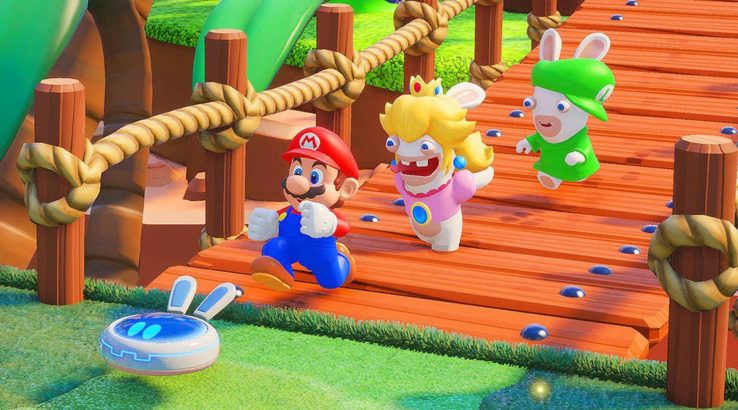It's safe to say that, upon being leaked, very few were optimistic about the release of a turn-based strategy game that featured Super Mario and Rabbids characters interacting with one another. After the title's official unveiling at E3 2017, however, gamers got a closer look at what this partnership between Nintendo and Ubisoft had come to look like and the tune of skeptics quickly changed. Now Mario + Rabbids Kingdom Battle is complete and ready to head off into the hands of Switch owners, and it's well worth checking out.
For those that aren't all that familiar with the contents of Mario + Rabbids Kingdom Battle, the title falls within the turn-based tactical genre. Many will find the action similar to the longstanding XCOM series – albeit modified to be a lot more accessible – but this is the most apt way of describing the experience found within this Ubisoft-developed adventure. In truth, the game feels immediately unique as a result of the meshing of one familiar universe and one not so recognizable one.
Battles play out with three player-selected characters, half of which originate from the Mushroom Kingdom and the other half made up of friendly Rabbid doppelgängers. They square off against a menagerie of other Rabbids that have been fused with known Super Mario baddies, which is the crux of the entire narrative at hand. Bowser Jr. has gotten his hands on a timid Rabbid named Spawny who is capable of fusing characters together that then do battle with Mario and friends – resulting in fleshed out creatures like Rabbit Kong, which is sure to become a favorite amongst fans of the title.
While that boss in particular is a wonderful meshing of worlds, the standard enemies that rotate in during any given encounter quickly begin to feel stale. As a result, strategies will be developed by users for handling these individual classes as soon as they are encountered, and said strategies can be utilized despite the variety of landscapes that they'll find themselves in. Given the wide array of iconic Bowser minions that Ubisoft had at its disposal, the developer only sparingly implements the likes of Chainchomps, Goombas, and Boos as stage hazards and hub world gags rather than addressable threats, which feels like a missed opportunity since the studio could have added more variety to the combat of Kingdom Battle through these antagonists.
Despite standard enemies lacking the depth of the significantly more engaging bosses scattered throughout Mario + Rabbids, the eight controllable heroes provide enough variety in their arsenals to cover standard class structures found within comparable titles within the genre. For example, Mario provides a well-rounded soldier with range and a melee armament, while the Rabbid version of the intrepid plumber is a close range combatant equipped with a shotgun-inspired cannon. Whether in need of a sniper, machine gunner, or explosives expert, there's a role filled by all of the characters available and juggling them as the situation calls for it is key to walking away with a gold trophy rating.
As the difficulty ramps up in the later game, points can be earned and spent on building the skills and powers of each teammate. These skill trees have been made accessible through shared levelling across all of the soldiers, meaning that each soldier will grow concurrently with their allies as points are gathered – allowing players to keep their entire roster up to snuff. This is balanced through the weapons system which requires fans to purchase upgraded armaments with the coins they earn through battle or stumble upon in the hub world, but that may not provide the sort of depth that hardcore followers of turn-based tactical games were hoping for.
It's clear that Ubisoft has opted to prioritize accessibility with Mario + Rabbids Kingdom Battle, which makes plenty of sense given the intellectual properties involved. Comparably, XCOM has a strong focus on chance and playing the odds, with various successful shot percentages and planning required to provide soldiers with a higher percentage of walking away from an encounter with their lives intact. On the other hand, Kingdom Battle has three shot percentages in the form of full cover (0% odds), partial cover (50% odds), and no cover (100% odds) which tones down the analytical nature of the genre in favor of pursuing a wider audience. This is a change of pace that will be received subjectively by the individual playing, but there's a lot to love about this accessible layout as well.
As gameplay may drag in certain combat-heavy sections, the world created by the Rabbids' involvement acts as a surprisingly wondrous foil to the Mushroom Kingdom. Focusing on the slapstick nature of the Ubisoft mascots, there are moments that are genuinely laugh-out-loud funny While not all jokes or references land, what does hit helps to create a crossover that brings the comedy of the Rabbids I.P. into what is traditionally a much more linear Nintendo franchise. Add in the wonderfully crafted musical score from Grant Kirkhope, known for composing soundtracks for Rare classics like Banjo-Kazooie, and there's an immediate intrigue that feels simultaneously familiar and foreign as beloved mascots trek through an amalgamation of their worlds.
Ubisoft has ensured that the hub world that fans will find themselves traversing through is filled to bursting with collectibles, puzzles, and viewable chaos to take in. These act as distractions from the combat found within and helps to make the pacing of the action flow a lot better. Just as waging war with hybrid bunnies starts to feel tedious, a series of puzzles will show up that give gamers a bit of a reprieve. Outside of these puzzles, there's also variety injected into the battles through significant changeups in the goals from time to time, ranging from standard fights that require players to take out all of the enemies present on screen to escort missions and "get from Point-A to Point-B" endeavours.
As these tasks are addressed and the single-player portion winds down, fans have the opportunity to delve into the co-op mode of Mario + Rabbids. Teaming up with a friend locally, each player is put in control of two characters (allowing a total of four allies on-screen at once) and they'll must then work together to clear out baddies while ensuring that there's no friendly fire or villainous flanking going on. It's a fun mode that makes wonderful use of the multiplayer nature of the Nintendo Switch console, although having the option to play through the main narrative with a friend – regardless of the balancing act that would have been necessary from a design standpoint to make this happen with an extra character – would have been a much more ideal layout.
During the 20+ hours that can be plugged into Mario + Rabbids Kingdom Battle's campaign, fans will be exposed to a funny and visually engaging world worth exploring that features some genuinely challenging portions of combat. Reoccurring enemies may weigh down an otherwise varied universe, but the end result of this partnership between Ubisoft and Nintendo is a wonderful, tactics-heavy venture that Switch owners won't want to let pass them by.
Mario + Rabbids Kingdom Battle is available exclusively for Nintendo Switch on August 29, 2017.




